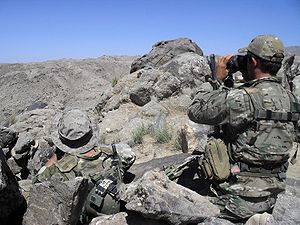Shah Wali Kot Offensive
| Shah Wali Kot Offensive | |||||||
|---|---|---|---|---|---|---|---|
| Part of the War in Afghanistan (2001–present) | |||||||
 Two Australian soldiers during the Shah Wali Kot Offensive |
|||||||
|
|||||||
| Belligerents | |||||||
|
|
|
||||||
| Strength | |||||||
| ~100+ men | |||||||
| Casualties and losses | |||||||
| 2 wounded | Around 100 believed killed | ||||||
The Shah Wali Kot Offensive was a five-day joint operation during the War in Afghanistan, conducted by Australian special forces and the Afghan National Army with US air support, between 10–14 June 2010. The operation took place in the Shah Wali Kot District of Kandahar Province, occurring in preparation for the coalition clearance of the province and resulting in heavy insurgent casualties.
In June 2010 the International Security Assistance Force (ISAF) began Operation Hamkari as part of an attempt to increase security around the southern city of Kandahar, in Afghanistan. As part of the operation Australian forces were tasked with conducting a series of disruption operations in the Shah Wali Kot district of northern Kandahar province. A five-day air mobile operation subsequently began in the second week of June, targeting an insurgent stronghold which had been controlled by the Taliban since 1995. Forces involved included the Australian Special Operations Task Group and Afghan National Army units, supported by United States Army helicopters From 1st Battalion, 101st Aviation Regiment, known as Task Force No Mercy.
Alpha Company Group from 2nd Commando Regiment made the initial attack on 10 June, and was later reinforced by a troop from the 2nd Squadron, Special Air Service Regiment (SASR) when it was discovered that the insurgents were preparing a counter-attack. Fighting was particularly intense on the second day of the operation when Australian and Afghan soldiers were fired upon by insurgents shortly after they disembarked from their helicopters during an assault into Tizak, with the engagement lasting for 13 hours. After five days of fighting the surviving insurgents withdrew from the area.
Following the operation the ISAF stated that an insurgent force numbering over 100 strong had been defeated. The commander of Australian forces in the Middle East, Major General John Cantwell claimed that the operation had "dealt a major blow to the insurgent forces and their commanders and made a major and direct contribution to ISAF security operations focused on Kandahar province and its nearby districts" and would also improve security in Oruzgan province. The Australian troops also captured large numbers of weapons during the operation.
...
Wikipedia
